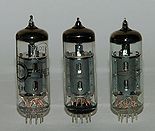
6P1P
Encyclopedia

Beam tetrode
A beam tetrode is a type of vacuum tube specially designed to produce greater output power than a similar pentode...
vacuum tube
Vacuum tube
In electronics, a vacuum tube, electron tube , or thermionic valve , reduced to simply "tube" or "valve" in everyday parlance, is a device that relies on the flow of electric current through a vacuum...
with ratings similar to the 6AQ5
6AQ5
The 6AQ5 is a miniature 7-pin output beam tetrode. Ratings are virtually identical to the 6V6 at 250V and was commonly used as an output audio amplifier in tube TVs and radios. Also known under Mullard-Philips tube designation EL90...
, EL90 and the 6V6
6V6
The 6V6 is a beam-power tetrode, introduced by Radio Corporation of America RCA United States in late 1937, and still in use in niche applications.Similar to its predecessor the 6L6, the 6V6 was far more widely used...
. Because of a different pinout (a 9-pin base versus 7-pin base) than an 6AQ5/EL90, it cannot be used as a plug-in replacement for these types, however, it will work in the same circuit with component values unchanged. Its maximum plate/screen voltage and dissipation ratings are actually slightly higher than a 6AQ5
6AQ5
The 6AQ5 is a miniature 7-pin output beam tetrode. Ratings are virtually identical to the 6V6 at 250V and was commonly used as an output audio amplifier in tube TVs and radios. Also known under Mullard-Philips tube designation EL90...
. A ruggedized/extended ratings version of the tube is designated 6P1P-EV (Russian: 6П1П-ЕВ) roughly equivalent to the 6AQ5W. A Chinese
China
Chinese civilization may refer to:* China for more general discussion of the country.* Chinese culture* Greater China, the transnational community of ethnic Chinese.* History of China* Sinosphere, the area historically affected by Chinese culture...
-manufactured version of the tube also exists, labeled 6P1.
The type was commonly used in Soviet-built vacuum tube radios and TV sets as an output audio amplifier, until it was replaced by the higher-performance 6P14P (EL84
EL84
The EL84 is a vacuum tube of the power pentode type. It has a 9 pin Noval base and is found mainly in the final output stages of amplification circuits, most commonly now in guitar amplifiers, but originally in radios and many other devices of the pre-transistor era.It was developed to eliminate...
) tube.
The tube is no longer believed to be in production.
Also see 6AQ5
6AQ5
The 6AQ5 is a miniature 7-pin output beam tetrode. Ratings are virtually identical to the 6V6 at 250V and was commonly used as an output audio amplifier in tube TVs and radios. Also known under Mullard-Philips tube designation EL90...
, 6V6
6V6
The 6V6 is a beam-power tetrode, introduced by Radio Corporation of America RCA United States in late 1937, and still in use in niche applications.Similar to its predecessor the 6L6, the 6V6 was far more widely used...
and Russian tube designations
Russian tube designations
- Receiver tubes :In the 1950s a 5-element system was adopted in the Soviet Union for designating receiver vacuum tubes....
.
External links
- http://www.ominous-valve.com/russtube.html - Russian/Soviet tube manufacturers and their logos.

